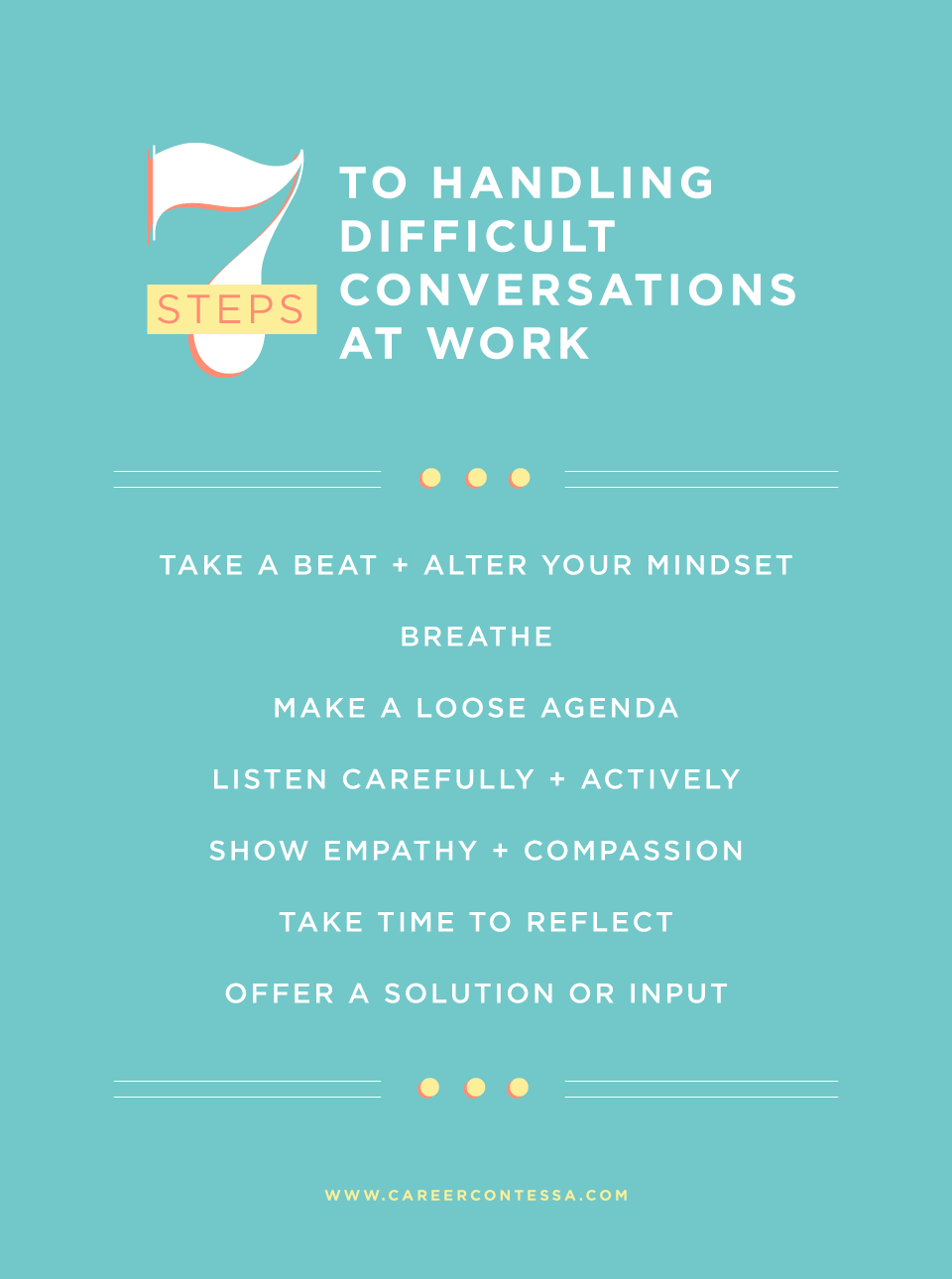Nobody likes difficult conversations.
Whether with loved ones, friends, or coworkers, we typically spend our lives avoiding the inevitability of a difficult conversation. However, when it’s time for them to happen, they have to just—well, happen.
Work conversations can be especially difficult—especially when emotion is involved—because you have to maintain a modicum of professionalism and respect.
Table of Contents
Before we go into our process for having difficult conversations at work, let's talk about some of the tougher conversations to have—and why they're so tough.
Common Types of Difficult Conversations at Work
The workplace is typically not the place for the more difficult "life" conversations, but sometimes challenging conversations happen. Here are some common conversations that are tough (but essential) to have sometimes.
Asking for a raise
Asking for a raise is a nerve-wracking conversation for an employee, but it's an inevitable part of progressing your career. Lucky for you, we have lots (and lots) of advice on how to ask for a raise. Namely, we love to use our
GIMME script to help employees create a point-by-point ask for an increased salary.
Reporting abuse, sexual harassment, or other bad behaviors
If you're witnessing abusive behavior or if you're the target of sexual harassment, it's imperative that you speak up. Abusive behavior has no place in the modern workplace. Whether it's repeated microaggressions, inappropriate language, misogyny, or blatant abuse, speak up.
Because this is arguably one of the toughest (and most triggering) conversations that nobody wants to have, we'd also recommend having an advocate to sit with you. Your voice deserves to be heard—and you're protecting future victims, too.
Here are more resources:
Communicating vulnerability
Vulnerability is tough to communicate at work. If your culture is "heads down" and "business only" then communicating vulnerability can seem like it's near impossible.
However, if an illness, a family situation, or a general discomfort around work is repeatedly affecting your work, it's time to communicate.
Giving negative feedback
Feedback is nerve-wracking to give and to receive. If you're a newer manager tasked with giving tough feedback, you can do this. First, take a breather.
When communicating negative feedback, our number one piece of advice is to focus on the thing, not the person. If it's behavior, like being constantly late or error-prone, communicate that. Separate the work or behavior from the person. In this way, the employee will not feel personally attacked. From there, open the discussion so that you can work together toward a solution.
Establishing (or re-establishing) boundaries
Establishing boundaries is something we should all do from day one. Boundaries can include your working hours, how you like to communicate, where you're willing to extend your energy beyond the scope of your job, and how you conduct your relationships with other employees. When boundaries don't exist, lines get blurry. This is especially prevalent when an employee gets promoted to a manager role.
The problem is that many of us don't ever establish boundaries in the first place. We'd recommend establishing boundaries for yourself—even if you don't feel like sharing them upfront. This will give you a framework for how you conduct yourself. We have other resources for establishing boundaries. Check them out here:
Admitting a (big) mistake
Have you ever made a mistake at work that you had to report? It's the difference between being caught and catching yourself. Sometimes, catching your own mistakes is even more difficult. While you deal with your own recourse from a costly mistake, you also have to communicate it to leadership. You'll be ok.
Our advice is to come clean. Be upfront, express regret, and come prepared with recourse, if possible. Don't try to cover up, manipulate, or place blame. Admitting a mistake and working immediately towards a solution should show leadership your valuable soft skills like problem-solving and critical thinking. Here's more on how to rebound from a mistake at work. Hey, maybe it will even be a funny story down the line. Maybe?!
7 Steps to Make Difficult Conversations...A Little Easier
Here’s our seven-step process to have on hand for any difficult conversation at work. Use these seven steps when you’re being called out for a mistake, when you’re confronting a
coworker about a lazy attitude, or when you’re finally asking for that
salary increase. It works for both sides of any difficult conversation. Here we go.
1. Take a beat and alter your mindset
Not every difficult conversation is going to be “confrontational” per se, but let’s use a confrontational conversation to begin with. Whether you’re the confronter or the confronted, you are going to enter this difficult conversation with a particular mindset. If you’re being confronted by your boss, your mindset might be, “She is wrong,” or “I’m sick of this job, anyway.”
On the other side, if you’re a manager confronting your employee, you might go in with a mindset like, “I am tired of this careless behavior,” or “This mistake has cost me xx dollars.”
Before entering into a difficult conversation—whether planned or unexpected—take a beat. Slow down,
identify your mindset, and push it aside. Entering any two-sided conversation with an immovable stance is going to get you nowhere. This is kind of like avoiding political talk over the Thanksgiving turkey.
Take a moment, identify, and abandon your mindset (at least for now.)
2. Breathe
If you’ve been following our
podcast, you know that we are newly-minted fans of
mindfulness and meditative breathing.
Difficult conversations on the horizon or not, practice mindfulness throughout the day. This can mean taking a minute to breathe when you’re walking down the hallway to the restroom, taking five minutes in the break room at lunchtime, or taking a mindful walk while quietly, mindfully, and non-judgementally taking the world in around you.
Ahead of a difficult conversation at work, practice some mindful breathing. If it’s a conversation you’re particularly nervous about having, this will give you time and space to cool down your heart rate, to center your thoughts, and to abandon that pesky mindset we spoke about earlier.
3. Make a loose agenda
When our emotions are heightened and we’re having tough conversations, we can forget some of our main points. If you are having a planned conversation, make a list of your main talking points.
If you become flustered or overwhelmed, take a deep breath, and refer to your agenda. For example, if you’re having that conversation when you finally ask for a raise, make a few bullet points about your major achievements, milestones, and client wins.
4. Listen carefully + actively
Here’s something we talk about a lot here at Career Contessa. Listen.
Listening sounds easy enough, but it can actually be quite difficult, especially in a challenging conversation. We’re all guilty, especially in a confrontational discussion, of waiting for the other person to stop speaking to interject our points.
If you’ve set aside your mindset, listening should come a little easier. Let the other party make her point entirely, take your beat, then use mirror language that indicates you have been listening.
For example, if your manager expresses that she is frustrated by your missed deadlines, respond with her language. “I understand that you are frustrated that I missed a few deadlines in recent history.”
Listening is paramount in seriously all workplace communication. It’s our belief that active listening stops any
potential problems in their tracks, shows a high level of respect and empathy, and improves overall communication.
5. Show empathy + compassion
The next thing you want to do, in any difficult conversation, is to show
compassion and empathy. This means, no matter what difficult conversation you’re having, it’s taking into account the other person’s point of view.
This might mean setting aside your own feelings or emotions in regards to this difficult conversation. Take a beat, allow the other participant to express their side of the story, then proceed. Keep in mind that the narrative you have in your mind might be completely misguided (it happens!) and listen with empathy.
6. Take time to reflect
Whether you’re giving or receiving bad news, it’s important to take time to reflect, to offer questions or answers, and to give the other person space to do the same.
We have hit upon the point of slowing down, taking a beat, and taking a few breaths a couple of times. Often, these conversations are so challenging and uncomfortable to have that we speed right through them. By slowing the process down a bit, it allows both parties to communicate, to listen, and to gain perspective from the other. For example, a layoff is an incredibly uncomfortable conversation to have. But, guess what? Nobody in the room wants to be having it.
Take time, towards the end of the conversation, to reflect. If you find that you are overwhelmed with thoughts or emotions, offer to have a follow-up meeting or email exchange where details can be ironed out.
7. Offer a solution or input
Wherever you see the chance, offer a solution, recommendation, or alternative.
If you are having a difficult conversation about a coworker’s missed deadlines, offer a project management tool you can both use. If you are laying off an employee, offer to write recommendations, connect the employee with your network, or keep your communication lines open for further questions.
Wherever you can, offer a solution. This allows you both to work together to find a solution or alternative—one where both parties of this difficult conversation can learn to grow and thrive, whether together or while navigating separate paths.











